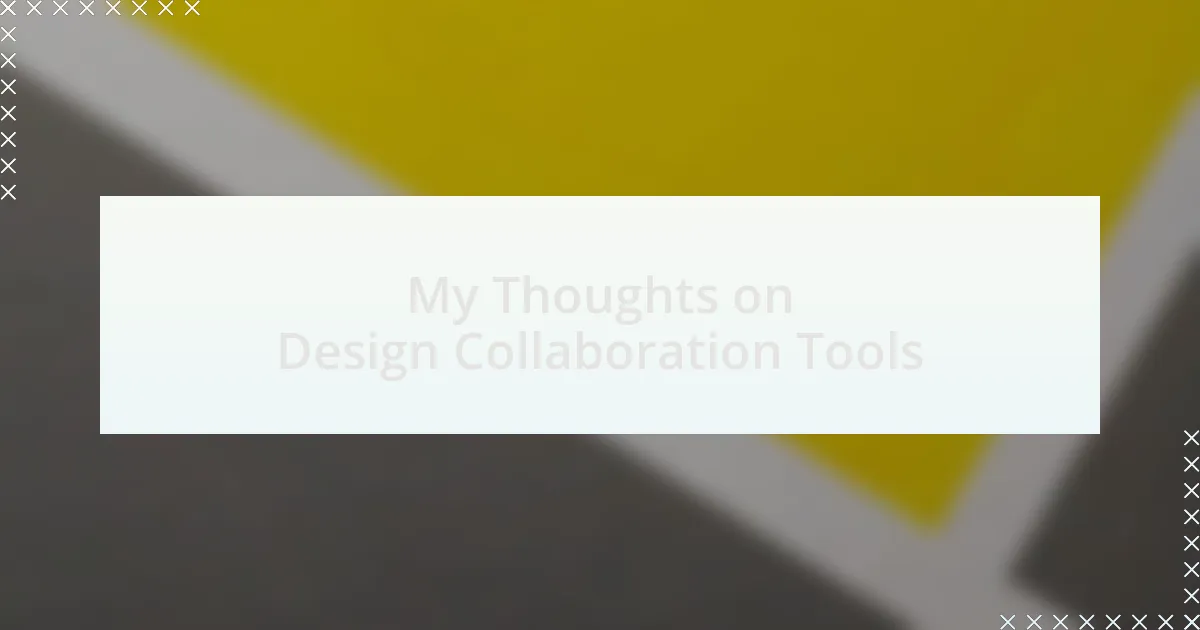Key takeaways:
- Design collaboration tools enhance productivity and foster a sense of community among team members.
- Collaboration brings diverse perspectives that enrich the creative process and nurture accountability.
- Popular design tools like Figma, Adobe XD, and Sketch improve communication and facilitate seamless iterations.
- Clear communication, defined goals, and regular check-ins are essential for effective design collaboration.
Author: Oliver Bancroft
Bio: Oliver Bancroft is an accomplished author and storyteller known for his vivid narratives and intricate character development. With a background in literature and creative writing, Oliver’s work often explores themes of human resilience and the complexities of modern life. His debut novel, “Whispers of the Forgotten,” received critical acclaim and was nominated for several literary awards. In addition to his fiction, Oliver contributes essays and articles to various literary magazines. When he’s not writing, he enjoys hiking and exploring the great outdoors with his dog, Max. Oliver resides in Portland, Oregon.
Introduction to Design Collaboration Tools
Design collaboration tools are essential for streamlining the creative process among teams. I remember the first time I stumbled upon a collaborative platform; it felt like a breath of fresh air. Suddenly, what used to take countless emails and endless revisions became a seamless exchange of ideas, and it made me wonder how I ever managed before.
These tools enable designers to share visuals, gather feedback, and iterate quickly with team members, regardless of location. I once faced a project where our team was spread across three different time zones, and without our chosen collaboration tool, I genuinely believe we would have struggled to keep our vision aligned. It’s incredible how these platforms not only enhance productivity but also foster a sense of community and shared purpose among designers.
As I delve deeper into various collaboration tools, I often ask myself—what truly sets the great ones apart? For me, it’s the blend of user-friendly interfaces with powerful features that invite creativity. The right tool can transform a group of individuals into a unified team, capable of crafting exceptional designs that resonate with audiences.
Importance of Collaboration in Design
Collaboration in design is crucial because it brings diverse perspectives together, enriching the creative process. I recall a particularly challenging project where a colleague introduced a slightly different viewpoint. That fresh angle not only enhanced our design but completely transformed the way I thought about problem-solving as a designer. It made me realize how essential it is to embrace different opinions; after all, aren’t we all striving for innovation?
When designers collaborate, they aren’t just sharing files—they’re building relationships and trust, which are vital for delivering exceptional work. I once worked with a team where the bond between members led to spontaneous brainstorming sessions. Those moments of synergy sparked ideas that none of us could have produced alone. Don’t you find that the most rewarding designs often stem from deep collaboration?
Furthermore, collaboration nurtures accountability, as team members motivate each other to uphold high standards. I remember the pride I felt when my teammate shared a breakthrough idea during a design review, pushing us all to elevate the project. It had me thinking—doesn’t having someone to challenge and inspire you only enhance the end result? In this way, collaboration becomes not just a necessity, but a catalyst for our best work.
Overview of Popular Design Tools
Design tools have proliferated in recent years, making the landscape rich with options. I personally lean towards tools that not only streamline the creative process but also enhance communication among team members. For example, Figma has been my go-to for its collaborative features, allowing real-time updates that keep everyone on the same page. Have you ever felt frustrated waiting for feedback on a design? Figma’s immediate collaboration alleviates that tension.
Another remarkable tool is Adobe XD, which I’ve found incredibly helpful for prototyping. Its ability to create interactive mockups has saved me countless hours, allowing for quick iterations based on team input. I remember a project where rapid testing through Adobe XD helped us pivot our approach just before the final presentation. Isn’t it fascinating how the right tools can lead to significant shifts in project outcomes?
Lastly, Sketch remains a classic among designers for its user-friendly interface and plugins. Having used it extensively, I appreciate how it nurtures creativity while keeping the design process focused. One thing I often ponder is this: How do the tools we choose reflect our design philosophy? I believe they should not just facilitate work but also inspire us to explore new possibilities.
Tips for Effective Design Collaboration
When working with a design team, clear communication is vital. I remember a project early in my career where we experienced major hiccups simply because we didn’t establish a shared vocabulary for our design elements. After that, I started insisting on creating a glossary of terms for every project. It’s amazing how a little clarity can eliminate confusion and streamline collaboration.
Setting clear goals for each design phase can also make a substantial difference. I learned this when I facilitated design sprints in my last role. Breaking down the project into smaller milestones helped not only in enhancing focus but also in fostering a sense of achievement among team members. Have you noticed how celebrating small wins often boosts morale?
Lastly, frequent check-ins can prevent misalignments and keep the energy flowing. I typically advocate for weekly stand-ups, where each team member shares updates and challenges they’ve encountered. This practice opens doors to real-time feedback and gives everyone a platform to voice their thoughts. Isn’t it refreshing to brainstorm together and witness how collective ideas spark innovation?

Leave a Reply